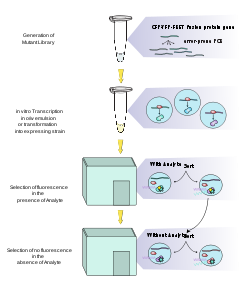- Directed evolution
-
Directed evolution is a method used in protein engineering to harness the power of natural selection to evolve proteins or RNA with desirable properties not found in nature.
Contents
A typical experiment
A typical directed evolution experiment involves three steps:
- Diversification: The gene encoding the protein of interest is mutated and/or recombined at random to create a large library of gene variants. Techniques commonly used in this step are error-prone PCR and DNA shuffling.
- Selection: The library is tested for the presence of mutants (variants) possessing the desired property using a screen or selection. Screens enable the researcher to identify and isolate high-performing mutants by hand, while selections automatically eliminate all nonfunctional mutants.
- Amplification: The variants identified in the selection or screen are replicated manyfold, enabling researchers to sequence their DNA in order to understand what mutations have occurred.
Together, these three steps are termed a "round" of directed evolution. Most experiments will perform more than one round. In these experiments, the "winners" of the previous round are diversified in the next round to create a new library. At the end of the experiment, all evolved protein or RNA mutants are characterized using biochemical methods.
Likelihood of success
The likelihood of success in a directed evolution experiment is directly related to the total library size, as evaluating more mutants increases the chances of finding one with the desired properties. Performing multiple rounds of evolution is useful not only because a new library of mutants is created in each round, but because each new library uses better mutants as templates. The experiment is analogous to climbing a hill on a landscape where elevation is a function of the desired property. The goal is to reach the summit, which represents the best mutant. Each round of selection samples mutants on all sides of the starting template and selects the mutant with the highest elevation, thereby climbing the hill. A new round samples mutants on all sides of this new template and picks the highest of these, and so on until the summit is reached.
In vivo and in vitro
Directed evolution can be performed in living cells (in vivo evolution) or may not involve cells at all (in vitro evolution). In vivo evolution has the advantage of selecting for properties in a cellular environment, which is useful when the evolved protein or RNA is to be used in living organisms, but in vitro evolution is often more versatile in the types of selections that can be performed. Furthermore, in vitro evolution experiments can generate larger libraries because the library DNA need not be inserted into cells, the currently limiting step.
Advantages
The advantage of the directed evolution approach is that the researcher need not understand the mechanism of the desired activity in order to improve it. An alternative method is rational design of site-directed mutagenesis based on X-ray crystallography data.
Uses
Most directed evolution projects seek to evolve properties that are useful to humans in an agricultural, medical or industrial context (biocatalysis). It is thus possible to use this method to optimize properties that were not selected for in the original organism. This may include catalytic activity, catalytic specificity, thermostability and many others.
See also
- SCOPE (protein engineering)
- Expanded genetic code
- protein methods and nucleic acid methods
- FIND Technology
Further reading
- Otten, L. G.; Quax, W. J. (2005). "Directed evolution: selecting today's biocatalysts". Biomolecular engineering 22 (1–3): 1–9. doi:10.1016/j.bioeng.2005.02.002. PMID 15857778.
- Besenmatter, W.; Kast P. and Hilvert D. (2004). "New Enzymes from Combinatorial Library Modules". Methods in Enzymology 388: 91–102. doi:10.1016/S0076-6879(04)88009-1. PMID 15289064.
- Reetz, M. T.; Carballeira J. D. (2007). "Iterative saturation mutagenesis (ISM) for rapid directed evolution of functional enzymes". Nature Prot. 2 (4): 891–903. doi:10.1038/nprot.2007.72. PMID 17446890.
- Stemmer, W. P. (1994). "Rapid evolution of a protein in vitro by DNA shuffling". Nature 370 (6488): 389–391. doi:10.1038/370389a0. PMID 8047147.
- Voigt, C. A.; Kauffman S., and Wang Z. G. (2001). "Rational evolutionary design: the theory of in vitro protein evolution". Advances in Protein Chemistry 55: 79–160. doi:10.1016/S0065-3233(01)55003-2. PMID 11050933.
- Arnold, F. H. (1998). "Design by directed evolution". Accounts of Chemical Research 31 (3): 125–131. doi:10.1021/ar960017f.
External links
- The Ulrich Schwaneberg Research Group
- The Frances H. Arnold Research Group
- The Huimin Zhao Research Group
- The Manfred T. Reetz Group
- The Donald Hilvert Group
- Darren Hart's Group
- The David Liu Group
- The Paul A. Dalby Research Group
- DNA2.0 Protein Engineering
- SeSaM-Biotech - Directed Evolution
- GENEART - Directed Evolution: Tools for Protein Engineering
- Codexis - Platform Technology
- DIREVO - Platform Technology
- Prof. Reetz explains the principle of Directed Evolution
Categories:
Wikimedia Foundation. 2010.

